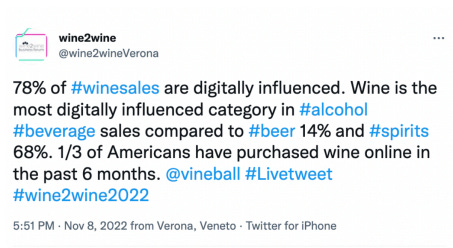More lies and damn statistics
One day soon we'll talk about how to do better market research in wine. But for now here are more reasons to be wary of the stuff you're already being told.
“Joe, I praise the day I met you! This is so freaking good.”
This is my favourite ever testimonial - received two days ago. If you are a wine producer or brand who needs affordable wine marketing help email me today and let’s chat. I will ensure you praise the day of our Lord 18th October 2023.
I just looked at a market research report for some work I’m doing. The report I found was $4,500. “Plus VAT”. I’ll be honest, the fact that I can reclaim the VAT isn’t making it seem a whole lot more affordable.
And I’ll take a punt. For most wine companies $4,500 + VAT isn’t affordable either.
So like most people I pick up insights where they can. And that’s often at wine conferences that look something like this…
(And yes, I’m referring to the back of a lot of male heads just as much as the nonsense on the screen.)
A lot of what you’ll be told at conferences will sound very convincing. This post is why you should be wary of large parts of it. And how to use two free (or at very least low cost) tools to make your own mind up about what you’re being told.
I was following a wine conference on Twitter last year, and one of the speakers said that…
This is an interesting finding. And it’s clear from these numbers that “digital” has some serious implications for wine producers.
Now as a wine producer you might be thinking – rightly – that social media is an important communication channel for you. Like they say, most wine sales are apparently digitally-influenced, whatever that means. It certainly sounds like social media. And a third - a THIRD - of Americans are buying wine online.
So we have two options.
Option one is to spend a lot of money on social media. A quick look at wine’s assorted hashtags on Instagram will tell you that lots of other people do that.
Option two is to look into the numbers a bit more carefully. A quick look at the profitability of many wine businesses will tell you not a lot of other people do that.
Proportion vs actual
“A third of Americans bought wine online in the last year”. It’s useful number. But remember - and I’m sure you’ve spotted this - it doesn’t mean that a third of American wine sales are online. Actually, that’s nearer 10%. In fact the data when this tweet came out was that 9.1% of wine sales were online. And they’d been boosted by Covid.
Conference speeches are (a) free market research, and (b) twisted to make powerful cases at conferences. They’re still useful, but good news numbers are almost certainly less impressive that they first sound. Although made to sound impressive so that you buy whatever the dude is selling.
Check the data
78% of wine sales are “digitally-influenced”. Now that’s a different kettle of fish. For starters, like Anthony Bourdain’s fish soup in The Big Short, you’ve no idea what’s gone into it.
A reasonable reading would be that it’s something to do with how much traffic social media drives to the places where people buy wine. Or at least find where they can buy wine?
This is where Similarweb can help us. Similarweb has several free searches. And I’ve used one of my free searches to see who, what, why, where, when, how… people use wine websites.
So what does Similarweb say about the power of social media to drive wine traffic to sales? Let’s see what proportion of wine-searcher and Vivino come from social media.
To read the rest of this post you need to be a paid subscriber. You’ll discover free and low cost tools, actionable insights, and an amusing YouTube video.
Keep reading with a 7-day free trial
Subscribe to Joe Fattorini's Substack to keep reading this post and get 7 days of free access to the full post archives.






